May 25, 2022 Kalakand is a popular Indian sweet that is made with milk. A lot of popular Indian sweets are milk-based, since that was the most commonly available ingredient back then it made sense for so many mithais to be made from milk. The traditional method of making kalakand involved curdling milk and then cooking it with sugar and more milk until the whole thing reduces to a thick paste-like consistency which can be set and cut into squares. The quicker way to make kalakand involves cooking curdled milk (chena) with condensed milk. While the traditional version is great, these days kalakand is made in different flavors. I have shared the recipe for this coconut rose kalakand before and today I am sharing another favorite of mine- Mango Kalakand! The sweet mangoes in season are pureed and then used to flavor this kalakand. If you love mangoes, then you would not want to miss out on this one.
Ingredients
Fresh chena: made from whole milk is what works best for this recipe. You can use store-bought paneer but honestly, the texture of kalakand is perfect when you make the Mango puree: I like using fresh mango puree made from sweet Alphonso mangoes (a variety of Indian mangoes). You can use any mangoes but make sure they are sweet. Canned mango puree is also okay but I would highly recommend using fresh if possible. The canned one is usually very diluted and not so flavorful. Condensed milk: even though we use sweet mango puree, it alone isn’t enough and so we use some condensed milk to make the kalakand sweet. Cardamom powder: I just add a tiny bit at the end but this is optional. You can skip it if you want only want mango flavor in your kalakand. Alternatively, if you prefer more flavors, you can even use saffron.
How to Make Mango Kalakand (Step by Step)
1- Add 2 liters of whole milk to a heavy bottom pan on medium heat. Let it come to a boil, this will take around 15 minutes, stir often in between so that the milk doesn’t stick to the bottom of the pan. Once it comes to a boil turn off the heat. 2- Add 3 tablespoons of vinegar, one tablespoon at a time, and stir after each addition. 3- You will notice the milk curdling and after a point, you will see it separated. If it doesn’t curdle even after adding 3 tablespoons vinegar, you can add another tablespoon. 4- Remove pan from heat. Line a strainer with cheesecloth and pour the curdled milk over it. The solids are what we call chena. Wash the chena with fresh water to remove the vinegar taste and smell. 5- Bring the ends of the cheesecloth together and squeeze water from the chena. Remember to not squeeze too much water also else kalakand can become dry but do squeeze water well. 6- Tie the ends of the cheesecloth together and then let the chena hang for around 20 minutes. I tied it to my sink tap. Meanwhile, line a 8 x 8-inch square pan with aluminum foil and lightly grease it with ghee or oil. 7- After 20 minutes are up, untie the cheesecloth. Add the chena to a wide pan along with 1 cup mango puree and 3/4 to 1 cup condensed milk. 8- Turn on the heat to medium and stir until it is all well combined. 9- Once everything is well combined, turn the heat to low-medium and start stirring the mixture. It will start becoming thick and leaving the sides of the pan. 10- When done, it comes together as a ball and comes together and becomes non-sticky and for me, it took around 25 minutes to reach this point on low heat. It can take you more or less depending on the intensity of the heat and the thickness of the pan. One way I like to test whether it has reached the right consistency or not is by pressing a clean spatula over the mixture. If nothing sticks to it, then it’s perfect and has reached the right stage to set. You don’t want to overcook also else the kalakand can turn chewy. 11- At this point, turn off the heat and add a little bit of cardamom powder to it (if using). Mix well. 12- Pour the mixture over the prepared pan. Using a spatula, spread it evenly, pressing it down as you spread. Sprinkle some finely chopped pistachios on top if you want. Let it set in the refrigerator for a minimum of 3 hours. Then cut into pieces and enjoy.
Storage
Since, this mango kalakand is a milk based sweet, it is best consumed with in 3 to 5 days. Keep it refrigerated at all times. It tastes best eaten fresh, preferably with in 48 hours.
Pro Tips
Use whole milk for the best results. You can use low-fat milk but I highly recommend using whole milk, it results in more and better chena for best kalakand.
Make sure to squeeze water from the chena before you tie it and let it hang for 20 minutes, but make sure to not make it dry. So, squeeze water but do not press it too hard. You don’t want to completely dry out the chena, that will make the kalakand hard.
The amount of time it will take to cook the kalakand to the right stage will depend on the thickness of the pan being used and the intensity of heat. It can take anywhere between 20 to 30 minutes, rather than going by the time, go for visual clues to make sure you have cooked the mixture to the right stage.
When done, the mixture will come together like a ball and leave the sides of the pan. It will become non-sticky. If you press a clean spatula on top of the mixture, nothing will stick to the spatula and that’s when you know it’s the right stage. Don’t over-cook after that point else the kalakand can become chewier.
Add cardamom powder at the very end for maximum flavor.
The amount of condensed milk in this recipe can be adjusted to taste. It also depends on how sweet the mangoes are, to begin with. If the mangoes are very sweet, use 3/4 cup condensed milk else use a full 1 cup. It’s lightly sweetened even with 1 cup in my opinion.
If you don’t have vinegar, you can also use lemon juice to curdle the milk.
If you’ve tried this Recipe then don’t forget to rate the recipe! You can also follow me on Facebook, Instagram to see what’s latest in my kitchen and on YouTube to watch my latest videos.
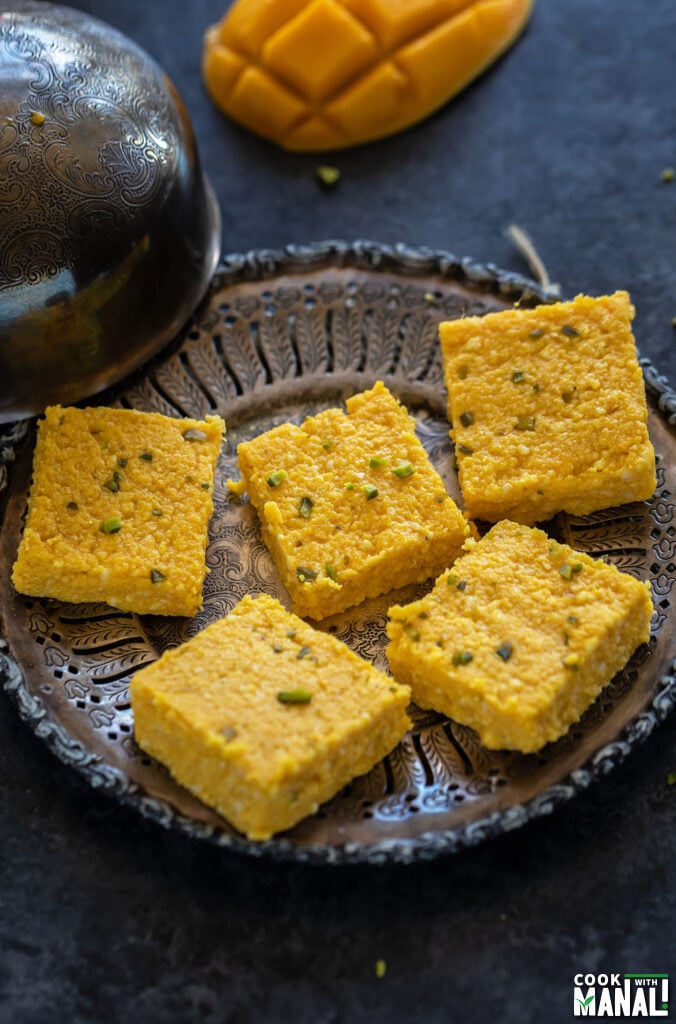
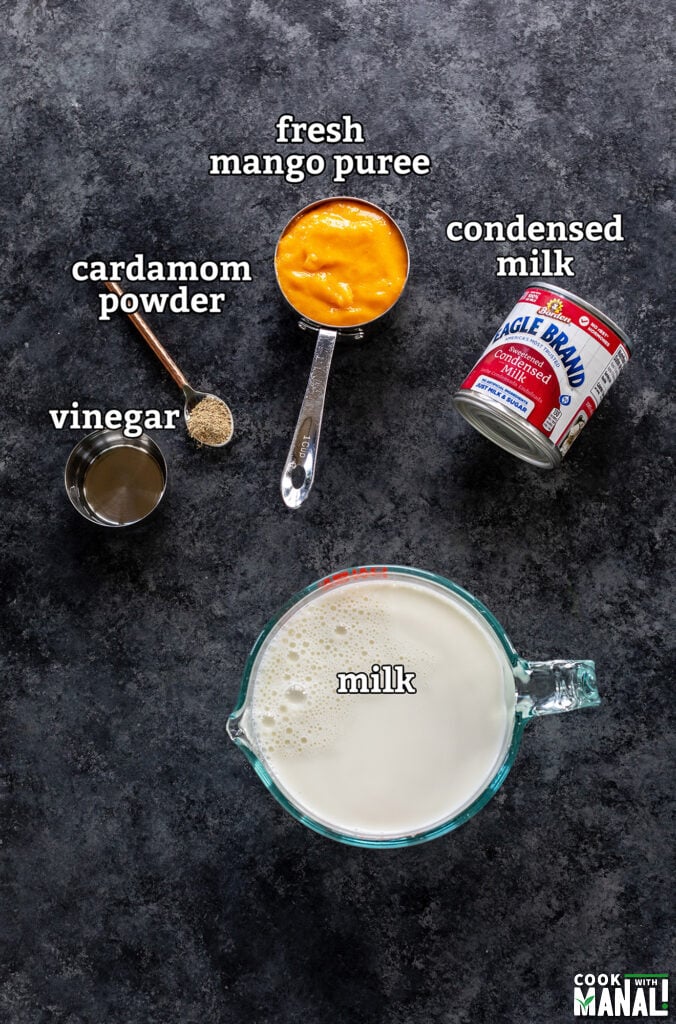
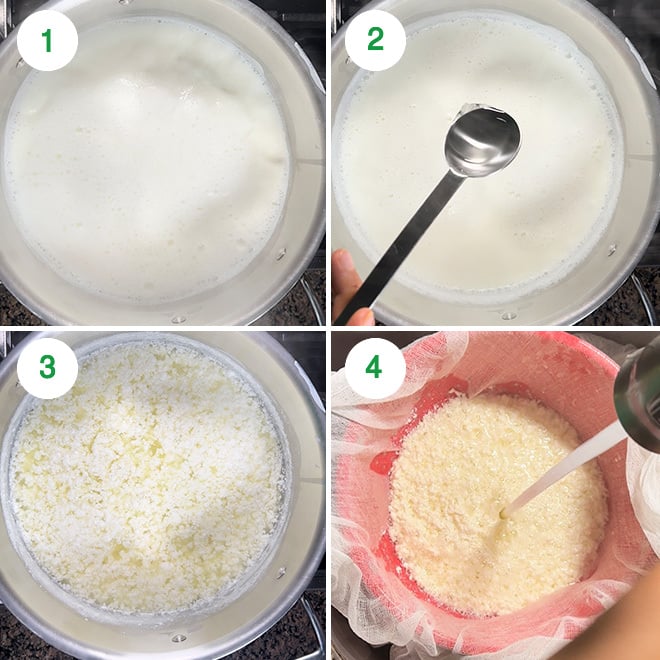
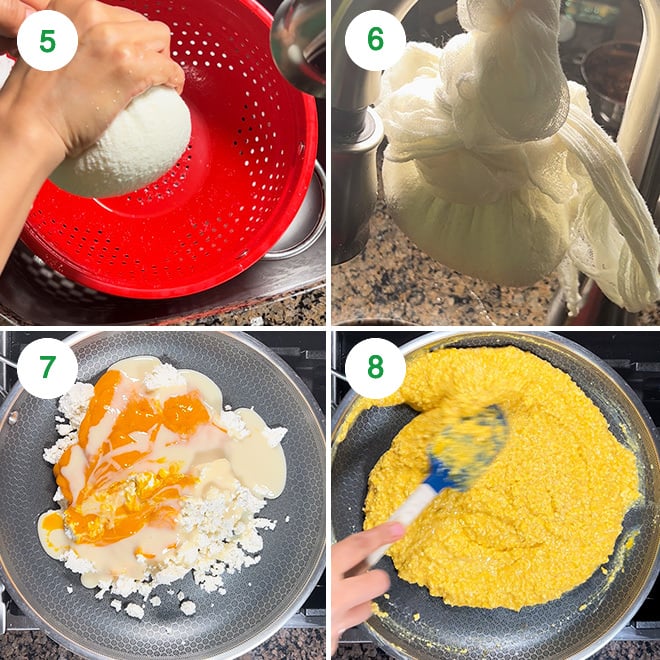
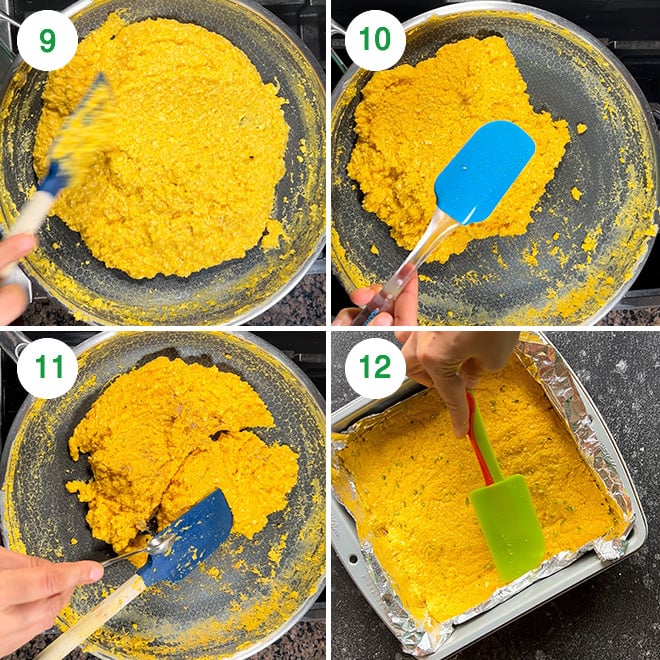
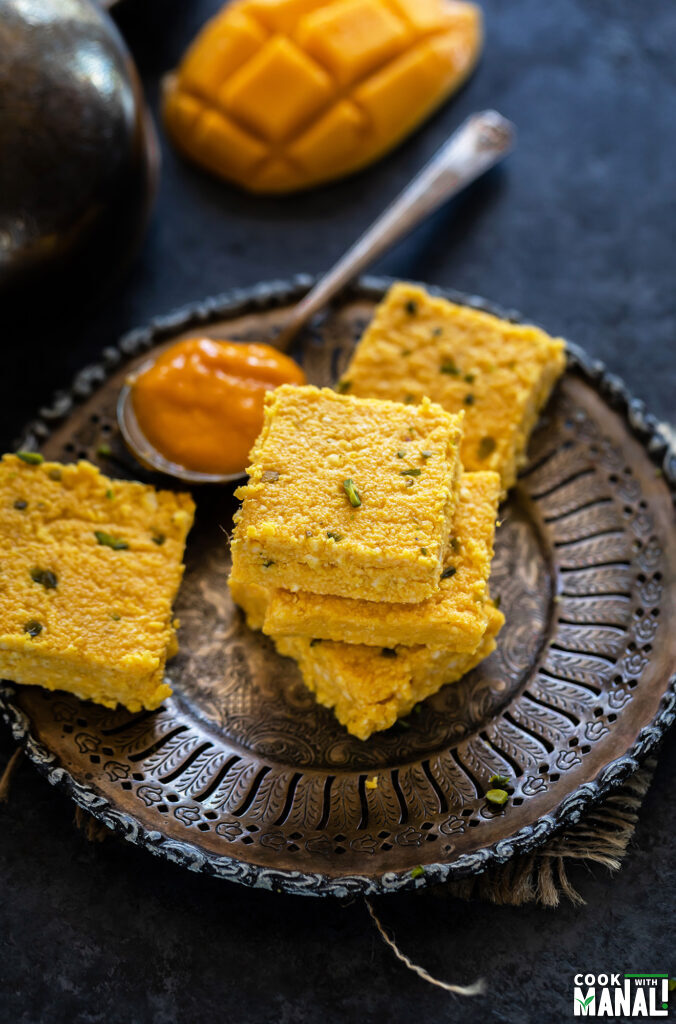
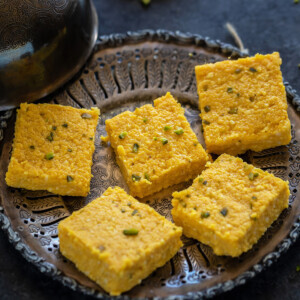
title: “Mango Kalakand " ShowToc: true date: “2024-11-01” author: “Scott Baker”
May 25, 2022 Kalakand is a popular Indian sweet that is made with milk. A lot of popular Indian sweets are milk-based, since that was the most commonly available ingredient back then it made sense for so many mithais to be made from milk. The traditional method of making kalakand involved curdling milk and then cooking it with sugar and more milk until the whole thing reduces to a thick paste-like consistency which can be set and cut into squares. The quicker way to make kalakand involves cooking curdled milk (chena) with condensed milk. While the traditional version is great, these days kalakand is made in different flavors. I have shared the recipe for this coconut rose kalakand before and today I am sharing another favorite of mine- Mango Kalakand! The sweet mangoes in season are pureed and then used to flavor this kalakand. If you love mangoes, then you would not want to miss out on this one.
Ingredients
Fresh chena: made from whole milk is what works best for this recipe. You can use store-bought paneer but honestly, the texture of kalakand is perfect when you make the Mango puree: I like using fresh mango puree made from sweet Alphonso mangoes (a variety of Indian mangoes). You can use any mangoes but make sure they are sweet. Canned mango puree is also okay but I would highly recommend using fresh if possible. The canned one is usually very diluted and not so flavorful. Condensed milk: even though we use sweet mango puree, it alone isn’t enough and so we use some condensed milk to make the kalakand sweet. Cardamom powder: I just add a tiny bit at the end but this is optional. You can skip it if you want only want mango flavor in your kalakand. Alternatively, if you prefer more flavors, you can even use saffron.
How to Make Mango Kalakand (Step by Step)
1- Add 2 liters of whole milk to a heavy bottom pan on medium heat. Let it come to a boil, this will take around 15 minutes, stir often in between so that the milk doesn’t stick to the bottom of the pan. Once it comes to a boil turn off the heat. 2- Add 3 tablespoons of vinegar, one tablespoon at a time, and stir after each addition. 3- You will notice the milk curdling and after a point, you will see it separated. If it doesn’t curdle even after adding 3 tablespoons vinegar, you can add another tablespoon. 4- Remove pan from heat. Line a strainer with cheesecloth and pour the curdled milk over it. The solids are what we call chena. Wash the chena with fresh water to remove the vinegar taste and smell. 5- Bring the ends of the cheesecloth together and squeeze water from the chena. Remember to not squeeze too much water also else kalakand can become dry but do squeeze water well. 6- Tie the ends of the cheesecloth together and then let the chena hang for around 20 minutes. I tied it to my sink tap. Meanwhile, line a 8 x 8-inch square pan with aluminum foil and lightly grease it with ghee or oil. 7- After 20 minutes are up, untie the cheesecloth. Add the chena to a wide pan along with 1 cup mango puree and 3/4 to 1 cup condensed milk. 8- Turn on the heat to medium and stir until it is all well combined. 9- Once everything is well combined, turn the heat to low-medium and start stirring the mixture. It will start becoming thick and leaving the sides of the pan. 10- When done, it comes together as a ball and comes together and becomes non-sticky and for me, it took around 25 minutes to reach this point on low heat. It can take you more or less depending on the intensity of the heat and the thickness of the pan. One way I like to test whether it has reached the right consistency or not is by pressing a clean spatula over the mixture. If nothing sticks to it, then it’s perfect and has reached the right stage to set. You don’t want to overcook also else the kalakand can turn chewy. 11- At this point, turn off the heat and add a little bit of cardamom powder to it (if using). Mix well. 12- Pour the mixture over the prepared pan. Using a spatula, spread it evenly, pressing it down as you spread. Sprinkle some finely chopped pistachios on top if you want. Let it set in the refrigerator for a minimum of 3 hours. Then cut into pieces and enjoy.
Storage
Since, this mango kalakand is a milk based sweet, it is best consumed with in 3 to 5 days. Keep it refrigerated at all times. It tastes best eaten fresh, preferably with in 48 hours.
Pro Tips
Use whole milk for the best results. You can use low-fat milk but I highly recommend using whole milk, it results in more and better chena for best kalakand.
Make sure to squeeze water from the chena before you tie it and let it hang for 20 minutes, but make sure to not make it dry. So, squeeze water but do not press it too hard. You don’t want to completely dry out the chena, that will make the kalakand hard.
The amount of time it will take to cook the kalakand to the right stage will depend on the thickness of the pan being used and the intensity of heat. It can take anywhere between 20 to 30 minutes, rather than going by the time, go for visual clues to make sure you have cooked the mixture to the right stage.
When done, the mixture will come together like a ball and leave the sides of the pan. It will become non-sticky. If you press a clean spatula on top of the mixture, nothing will stick to the spatula and that’s when you know it’s the right stage. Don’t over-cook after that point else the kalakand can become chewier.
Add cardamom powder at the very end for maximum flavor.
The amount of condensed milk in this recipe can be adjusted to taste. It also depends on how sweet the mangoes are, to begin with. If the mangoes are very sweet, use 3/4 cup condensed milk else use a full 1 cup. It’s lightly sweetened even with 1 cup in my opinion.
If you don’t have vinegar, you can also use lemon juice to curdle the milk.
If you’ve tried this Recipe then don’t forget to rate the recipe! You can also follow me on Facebook, Instagram to see what’s latest in my kitchen and on YouTube to watch my latest videos.






